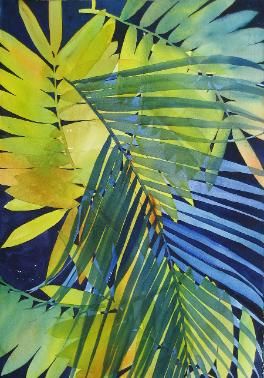Định nghĩa
Vẽ âm (negative) là vẽ vòng xung quanh chủ thể để tạo ra nó, chớ không phải vẽ chính vật thể này. Đa phần các họa sĩ đều vẽ dương (positive): vẽ đè lên trên.
Vẽ màu nước kiểu âm/vòng quanh : Là vẽ background tối (hơn) vòng quanh vật thể sáng (hơn). Nói cách khác là vẽ các vật thể từ gần đến xa, dần dần làm lộ hình dáng và tạo chiều sâu cùng kích cỡ của các vật thể này qua từng lớp màu.
Negative painting alternative approach in which the subject is established by painting around the object rather than by painting the object itself. Most painters work in the positive, typically adding one shape on top of another.
Negative Watercolor Painting: The basic idea is to paint a darker background around the lighter objects. In other words, you define various objects from close to distant, gradually revealing their shapes and creating more depth and dimension with each layer of color.
Cần ghi nhớ ba điều sau, khi vẽ âm:
- Các lớp đầu phải nhạt đến trung bình.
- Để khô hoàn toàn, mới láng lớp sau.
- Vẽ quanh vật thể, chứ không vẽ bản thân vật thể.
Three things to remember when using negative painting:
~ Begin with light to medium value washes because each subsequent glaze deepens previous ones
~ Dry the painting thoroughly between glazes
~ Paint the space around an object, not the object itself.
Luôn vẽ màu nhạt trước, vì các lớp láng sau sẽ đậm dần. Lớp màu nhạt này có thể loang cách positive shape một khoảng ngắn rồi biến mất, hoặc có thể loang hết cả background.
Always start with light value washes because subsequent glazes deepen previous ones. How far the color extends beyond the positive shape may vary from a short distance before fading out completely to covering the entire background.
Bài tập: Vẽ lá thu rơi (Painting Fallen Leaves)
Bước 1: Vẽ đường viền hình lá
Step 1: Draw a simple outline of the leaf shape.
Bước 2: Pha một vũng màu lớn, tông lá mùa thu ấm bằng: New Gamboge, Burnt Sienna, Orange (NG + Tiziano Red), and Green (NG + Ultramarine), sệt cỡ sữa vớt váng, độ nhạt đến trung bình.
Step 2: On your palette, mix large puddles of warm tones in Autumn shades: New Gamboge, Burnt Sienna, Orange (NG + Tiziano Red), and Green (NG + Ultramarine); they should be the consistency of skim milk in light to medium values.
Bước 3: Làm ướt mặt giấy bằng cọ bẹt. Thả vài giọt màu kể ở bước 2 lên giấy. Nghiêng giấy và để màu trộn và hoà vào nhau. Màu sắc nên khác nhau, không đều, để trắng đây đó. Để khô hoàn toàn.
Step 3: Thoroughly wet the surface of the paper with a flat brush and water. Use the variegated wash technique to drop in the colors in Step 2 around your paper. Tilt the paper and let the colors mix and mingle. The background should be varied — some white spaces are fine. Dry completely.
Bước 4: Dùng lá mẫu, sketch nhạt hình lá lên bên trái giấy, chừa chỗ để sau này thêm lá khác xung quanh.
Step 4: Use the pattern to lightly sketch a leaf on the left side of the paper leaving space for more leaves around it.
Bước 5: Khuấy màu, dùng cọ tròn to lấy một trong số màu trên. Bắt đầu loang gần chỗ vẽ, loang quanh lá này. Kéo màu về hướng rìa giấy, làm ướt rồi thấm cọ để màu loãng bớt để lớp màu loang nhạt dần. Vẽ nhanh và loang quanh hình, không để lại viền cứng kế bên chiếc lá. Để khô hoàn toàn.
Step 5: Stir your paint puddles and load your large round brush with one of the colors. Start near your drawing and paint around the positive leaf shape. Drag the color out toward the edge of the paper, wetting and blotting your brush to thin the color with a graduated wash as you do. Work quickly and glaze all around the shape, you only want hard edges next to the leaf shape. Dry completely.
Bước 6: Lặp lại bước 5 vài lần. Khi vẽ lá, hãy giấu một phần lá bên dưới các chiếc lá đã vẽ trước, để trông như lá nằm dưới lá. Loang màu quanh mọi lá như bên trên.
Step 6: Repeat the process in step 5 several times. When drawing the leaves, partially hide them beneath those you already painted so they appear to be beneath them. Glaze around all the leaves as above.
Để giấy khô rồi lặp lại. Nhỏ một màu khác vào màu ướt để có sắc thái đa dạng và làm đậm màu thêm một chút, để làm nổi các lớp nhạt hơn.
Dry the paper and repeat. Drop another color into the wet paint for variety and darken the value of your paint a bit to bring out the lighter layers.
Kéo màu ra xa hình lá, đến rìa giấy.
Pull the color away from the shapes and out to the edge of the paper.
Trong bài tập Lá rụng này có khoảng 7 lớp màu.
There are about seven glazes of color in this version of the Fallen Leaves exercise.
Vài tranh vẽ bằng kỹ thuật negative
Youtube clip dạy vẽ













.jpg)
Không có nhận xét nào:
Đăng nhận xét